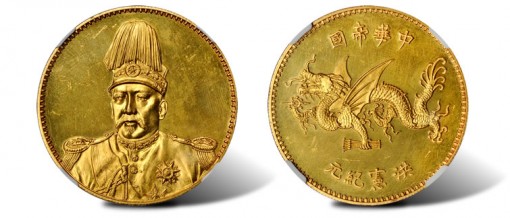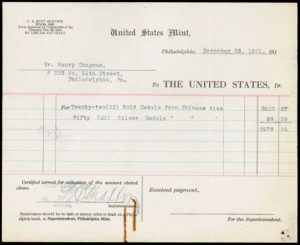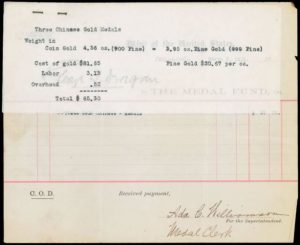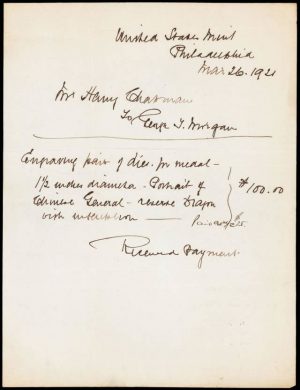After years of research, and convincing evidence in the form of receipts for purchases, I believe that the famous 1916 Yan-Shih-kai Dragon gold dollars were struck in the United States in 1921 for Philadelphia coin dealer Henry Chapman, and not made in China. The historic receipts will be offered in a public auction in Hong Kong in April.

1921 is an interesting era in numismatic history for it was during this period that Chapman had various coins specially made for him at the Philadelphia Mint. It is well-known and documented that in 1921 he ordered proof Morgan dollars from the Philadelphia Mint. What other coins did he have struck to sell to collectors?
For many years I have had three receipts that indicate Chapman had Chinese gold medals and silver medals struck at the U.S. Mint in 1921.

The first receipt from the Mint is dated November 25, 1921 to Henry Chapman for 22 Gold Medals from Chinese dies and 50 Silver Medals from Chinese dies; the second is from the U.S. Mint, dated March 2, 1921, to George T. Morgan for 3 Chinese Gold Medals; and the third is handwritten from the U.S. Mint, dated March 26, 1921, to Henry Chapman and George T. Morgan for a pair of dies for medals, 1 ½ inches diameter, portrait of Chinese General, reverse dragon with inscription.
The documents describe the coins as "medals," and there were no denominations indicated and references to them as dollars struck in gold. But as the coins have appeared on the market, they are referred to as dollars struck in gold.

George T. Morgan, born in Birmingham, England, in 1845, came to the United States from England in 1876 and was hired as an assistant engraver at the Mint in October of that year. He figured very prominently in the production of pattern coins from 1877 onward. To his hand can be ascribed some of the most beautiful of all patterns of the 1877-1882 era, including several varieties of 1877 half dollars and the 1879 "Schoolgirl" dollar.
Following Chief Engraver William Barber’s death in 1879, Morgan hoped that he would be named to the post. However, the nod went to Barber’s son Charles, a man of relatively few talents in the engraving field. Charles Barber remained in the position for many years, until his death on February 18, 1917. Subsequently, Morgan became chief engraver, but this was late in his life, and his "glory years" had already been spent in a secondary position. He remained chief engraver until his death on January 4, 1925.

The Chapman brothers, Henry and S.H., worked for John W. Haseltine in his Philadelphia coin shop in the 1870s, and then in 1879 started a business on their own. Their first sensational sale was the Bushnell Collection in 1882, after which they had a long string of successes. In 1906 they split up the partnership and both brothers went on their own, each registering many accomplishments over the years. Henry Chapman, more than S.H., was involved in maintaining an inventory and selling directly to customers.
The description of these "medals" struck at the Philadelphia Mint corresponds to the "Hung Hsien" dollar which is a dollar size coin but does not have the word DOLLAR in English or Chinese. This Hung Hsien "coin/medal" has never fit in with the other coins struck during this period.
I have been researching the origins of the receipts which I bought from George F. Kolbe about 15 years ago. Kolbe claims in the 1980s he purchased a large group of documents belonging to the Chapman estate, of which these receipts were a part. Kolbe purchased them from New York dealer, Freddie Warner, who in turn had bought the documents from New York dealer Ed Rice in the mid-1950s. Rice purchased the documents in Philadelphia along with many Chapman catalogs, took them to his farm near Cranbury, New Jersey, and proceeded to sell off the items over the years.
The 1916 issue is the most common of all the dollars struck in gold, coming up more often than other dates. The receipts list only 25 struck in gold and 50 in silver, but who knows if there were others struck for which no receipts have been discovered?
Listed in the Illustrated Catalog of Chinese Coins by E. Kann, 1916, 1 Dollar YUAN SHIH-KAI Hung Hsien Gold Coin (dated in Chinese – Beginning of the Hung Hsien Period) 39 mm in diameter, 3 mm thick, as #1560.
Most recently two 1916 China dollars struck in gold appeared in Stack’s Bowers & Ponterio’s Hong Kong Auction of August, 2011: Lots #70037 and #70038. Each is from completely different dies; and each has long pedigrees:
Lot #70037
Ex: King Farouk of Egypt Collection, "The Palace Collections of Egypt", Sotheby & co. London Auction conducted at Koubbeh Palace Cairo Egypt, February-March 1954, lot#1326.
Ex: Winter Collection, Stack’s January-February 1974 Auction, lot#76.
Ex: Chin Family Collection.
Lot #70038
Ex: King Farouk of Egypt Collection, "The Palace Collections of Egypt", Sotheby & co. London Auction conducted at Koubbeh Palace Cairo Egypt, February-March 1954, lot#1327.
Ex: Winter Collection, Stack’s January-February 1974 Auction, lot#77.
Ex: Chin Family Collection.
It is my opinion, pure speculation on my part, that Lot #70037 is one that was struck at the U.S. Mint on behalf of Henry Chapman.
The coin’s appearance is mushy, the plume on the hat is different, the breast badge is smaller and less defined, characters on the reverse are different. Compare to Lot #70038, which is noted as a "Rare Plume Variety," whose breast badge and coat buttons are more defined, the plume is different, characters on the reverse are different, overall the appearance is sharper. I believe Lot #70038 to be typical of the work of L. Giorgi and struck at the China Mint. Also, Lot #70037 is the same coin design mostly seen in silver and, as I have noted from the research I have done, has shown up often after 1920.
Many events occurred in the early years of the Republic of China and many interesting events took place at the Philadelphia Mint at the time. Following is historical speculation of what possibly happened behind the scenes in those early years:
Quoted from ‘The Illustrated Catalog of Chinese Coins’ by E. Kann, 1966:
In the summer of 1915, a movement began in favor of the re-establishment of a monarchy. A Convention of Citizens’ Representatives was summoned to decide the problem and voted unanimously in favor of the establishment of a Constitutional Monarchy, with Yuan Shih-kai as emperor. Before the enthronement could have taken place, a rebellion in Yunnan Province had assumed too serious proportions to make such a step prudent, and a mandate of February 23, 1916, postponed the date of accession indefinitely.
Another reliable source (see "Donald of China", by E.A. Selle, 1948) asserts that Yuan was surreptitiously crowned as emperor, but that such action was cancelled by a Mandate issued by Yuan Shih-kai on March 21, 1916. To quote literally: "In mid-December (1915), and after a unanimous convention of district delegates at Peking, Yuan, in a private and lavish ceremony, ascended the throne in the great throne-room in the Forbidden City. A system of royalty was set up. Friends of Yuan became barons, dukes and earls. For himself he took the title of ‘HUNG HSIEN’." On page 179 of the said book it is written: "On March 1 (1916) Yuan issued a Mandate canceling the monarchy and restoring the republic. Once again, Yuan was just ‘Mr. President’."
On June 6, 1916, Yuan Shih-kai died, and with him the monarchial scheme. As will be seen, gold, silver and copper coins with the confidently expected monarchial title styled HUNG HSIEN were actually struck in preparation of the auspicious event.
Did any of these events actually happen? Were any of these coins even produced in China? It is entirely possible that Henry Chapman had these "medals" made at the Philadelphia Mint to market as intriguing collectables based on murky knowledge and romanticized ideas of what actually took place in China a few years earlier.
These receipts from the Mint to Chapman will be sold in the Stack’s Bowers & Ponterio Hong Kong Auction of April, 2012.






How is it that this Chapman fellow was not arrested by the authorities, how much payola were you allowed to peddle back in the day. Even a snotty email to the government today will get the FBI/HSA/Secret Service attention. Anything goes back in the roaring 20’s.
Admit that I never was aware of most of the names mentioned, nor this numismatic event. I would appreciate however if you might provide some additional info as to relevance and how these coins/medals are noteworthy. Is this a niche collection, high dollar items? When you state that it is “your belief” does this provide additional value or detract from these items, and what will be in your opinion the bottom line impact of this research?
If Chinese coins are made in America, it must be counterfeit? Why did Philadelphia Mint made these Gold Chinese coins in 1916? So is these coins counterfeits?
Coins commissioned by one country to be minted by another country can’t be counterfeits – they’re authorized by the commissioning country. Perth and Ottawa make coins for lots of different countries who don’t have the capacity/ability to mint their own coins.
The Philadelphia Mint struck foreign coins under contract for decades. One of the more interesting cases occurred in 1968 when the Royal Canadian Mint couldn’t keep up with demand for new nickel-based coins following abandonment of silver coinage. The US had recovered from its own similar shortages and sold some excess capacity to strike dimes in parallel with the RCM. The coins’ face designs of course were identical (the sloop “Old Bluenose”) but Philadelphia presses were fitted with collars intended for American dimes. If you were very diligent you could tell which country minted a dime by counting its reeds.
I think the most interesting and criminal aspect of this minting is that they were minted in 1921 with a 1916 date, totally phoney coins minted by insiders, for insiders,might as well remint phoney dated double eagles while “just stamping” out coins for your buddies. I wonder if this stuff goes on today? Likely does, on the late shift, when the tourists have gone home.
I don’t know about today but it sure went on back then. Don’t forget Farran Zerbe’s “special strikes” (ha!) and the supposed shenanigans surrounding the 1913 Liberty nickels. Of course in the 19th century the Mint would effectively fill contracts for what I call “genuine fakes” like the first and second runs of 1804 dollars and a rumored 1868 Large Cent.
Now if only someone fiddled the count of 1964-D Peace dollars so that a couple survived. I’d love to be around long enough to see one of THEM surface !
I have the exact same coin here only that it’s not gold but silver…How much is it worth now? Just asking